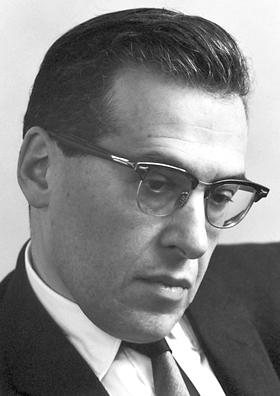07 Jan The Forgotten Genius of Physics
I started my graduate study in physics at Harvard University in 1956. Julian Schwinger had just completed his reformulation of Quantum Field Theory and was beginning to teach a three-year series of courses. I sat mesmerized, as did others.
 Attending one of [Schwinger’s] formal lectures was comparable to hearing a new major concert by a very great composer, flawlessly performed by the composer himself… The delivery was magisterial, even, carefully worded, irresistible like a mighty river… Crowds of students and more senior people from both Harvard and MIT attended… I felt privileged – and not a little daunted – to witness physics being made by one of its greatest masters. – Walter Kohn, Nobel laureate (“Climbing the Mountain” by J. Mehra and K.A. Milton)
Attending one of [Schwinger’s] formal lectures was comparable to hearing a new major concert by a very great composer, flawlessly performed by the composer himself… The delivery was magisterial, even, carefully worded, irresistible like a mighty river… Crowds of students and more senior people from both Harvard and MIT attended… I felt privileged – and not a little daunted – to witness physics being made by one of its greatest masters. – Walter Kohn, Nobel laureate (“Climbing the Mountain” by J. Mehra and K.A. Milton)
As Schwinger stood at the blackboard, writing ambidextrously and speaking mellifluously in well-formed sentences, it was as if God Himself was handing down the Ten Commandments. The equations were so elegant that it seemed the world couldn’t be built any other way. From the barest of first principles, he derived all of QFT, even including gravity. Not only was the mathematics elegant, but the philosophic concept of a world made of properties of space seemed to me much more satisfying than mysterious particles. I was amazed and delighted to see how all the paradoxes of relativity theory and quantum mechanics that I had earlier found so baffling disappeared or were resolved.
Unfortunately, Schwinger, once called “the heir-apparent to Einstein’s mantle” by J. Robert Oppenheimer, never had the impact he should have had on the world of physics or on the public at large. It is possible that Schwinger’s very elegance was his undoing.
Julian Schwinger was one of the most important and influential scientists of the twentieth century… Yet even among physicists, recognition of his fundamental contributions remains limited, in part because his dense formal style ultimately proved less accessible than Feynman’s more intuitive approach. However, the structure of modern theoretical physics would be inconceivable without Schwinger’s manifold insights. His work underlies much of modern physics, the source of which is often unknown even to the practitioners. His legacy lives on not only through his work, but also through his many students, who include leaders in physics and other fields. – “Climbing the Mountain” by J. Mehra and K.A. Milton
Schwinger is remembered primarily, if he is remembered at all, for solving a calculational problem in QFT called renormalization, for which he shared the 1965 Nobel prize with Sin-Itiro Tomanaga and Richard Feynman. Feynman’s particle-based approach, which had no theoretical basis, proved to be easier to work with than Schwinger’s (and Tomanaga’s) field-based approach, and Schwinger’s method was relegated to the archives. It is Feynman’s image, not Schwinger’s, that was enshrined on a postage stamp.
However Schwinger was not satisfied with his renormalization work:
The pressure to account for those [experimental] results had produced a certain theoretical structure that was perfectly adequate for the original task, but demanded simplification and generalization… I needed time to go back to the beginnings of things… My retreat began at Brookhaven National Laboratory in the summer of 1949. It is only human that my first action was one of reaction. Like the silicon chip of more recent years, the Feynman diagram was bringing computation to the masses… But eventually one has to put it all together again, and then the piecemeal approach loses some of its attraction… Quantum field theory must deal with [force] fields and [matter] fields on a fully equivalent footing… Here was my challenge. – from “The Birth of Particle Physics”, ed. by Brown and Hoddeson.
Schwinger’s final version of the theory was published between 1951 and 1954 in a series of five papers entitled “The Theory of Quantized Fields”. I believe that the main reason these masterpieces have been ignored is that many physicists found them too hard to understand. (I know one who couldn’t get past the first page.)
Schwinger went on from there to develop a new approach to Quantum Field Theory that he called source theory (and he called its practitioners “sourcerers”), which is also virtually unknown.
In addition to these momentous contributions to Quantum Field Theory, Schwinger had other accomplishments. As a 19-year old graduate student at Columbia University he was the first to determine the spin of the neutron. In 1957 he found the correct form for the weak field equations before Gell-mann and Feynman. He was the first to suggest electroweak unification, for which Sheldon Glashow, Steven Weinberg and Abdus Salam received the 1979 Nobel Prize. And he suggested the Higgs mechanism before Peter Higgs, who shared the 2013 Nobel Prize with Francois Englert.
There is no doubt that Julian Schwinger more than fulfilled his promise as “the heir-apparent to Einstein’s mantle”, and yet many physicists – let alone the general public – don’t even know his name. As I wrote in the preface to my book (see quantum-field-theory.net):
But most of all I dedicate this book to the memory of Julian Schwinger, one of the greatest physicists of all time and, sadly, one of the most forgotten. It was Schwinger who turned Quantum Field Theory into the beautiful structure that I have tried to convey to a wider public.
To Read more about Quantum Field Theory, Click Here

Sorry, the comment form is closed at this time.